1.Fork-Join
1.1 分而治之的设计思想:
将一个难以直接解决的大问题,分割成一些规模较小的相同问题,以便各个击破,分而治之。
分治策略:
对于一个规模为n的问题,若该问题可以解决,则直接解决,否则将其分解为K个模块较小的子问题,这些子问题相互独立且与原问题形式相同(子问题相互之间有管理就变成了动态规范算法),递归的解决浙西子问题,然后将子问题的解 合并得到原问题的解。
1.2 Fork/Join框架:
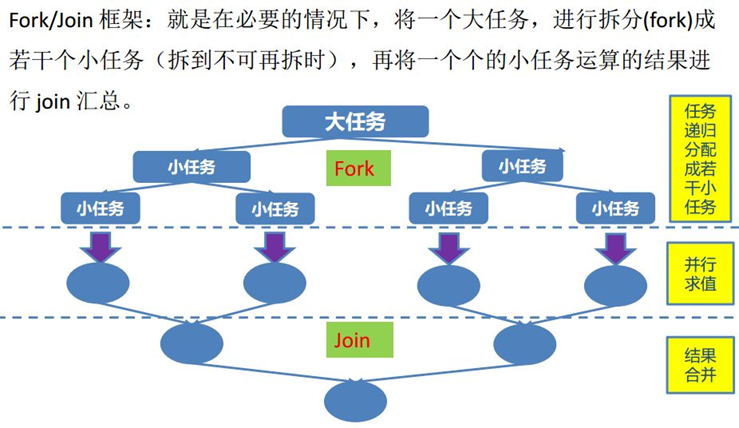
工作密取:
在“生产者—消费者”模式中,生产者和消费者共享一个队列,而在工作密取的情境中,每个消费者都有一个双端队列,在消费者完成了自己队列中的工作时,可以去其他消费者队列的队尾取来工作,而并不会干扰其他消费者的工作。在工作密取情境中,消费者从自己队列的队头取自己的工作,从其他消费者的队尾取别人的工作来完成。
工作密取非常适合于消费者同时也是生产者的情形,当消费者执行工作时发现有更多的工作要做,则可以将这些工作放到自己队列的末尾,也可以送到其他消费者队列的队尾;当自己队列没有工作要做时,可以去其他消费者队列取工作来完成,这样每个消费者都会保持忙碌的状态。
ForkJoinPool中维护着多个线程(一般为CPU核数)在不断地执行Task,每个线程除了执行自己职务内的Task之外,还会根据自己工作线程的闲置情况去获取其他繁忙的工作线程的Task,如此一来就能能够减少线程阻塞或是闲置的时间,提高CPU利用率。
1.3 Fork/Join使用的标准范式
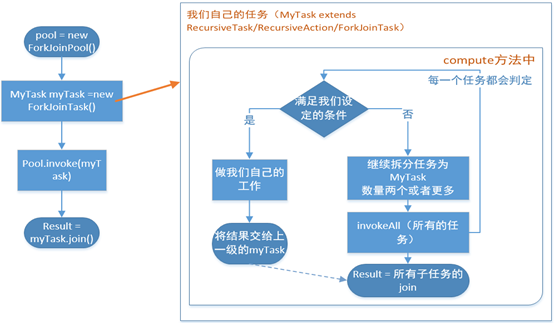
ForkJoinPool pool = new ForkJoinPool(); MyTask myTask = new MyTask(); pool.invoke(myTask); result = myTask.join();
=================================================
//invoke方法:
public <T> T invoke(ForkJoinTask<T> task) {
if (task == null)
throw new NullPointerException();
externalPush(task);
return task.join();
}
MyTask为我们自己的任务 可继承自
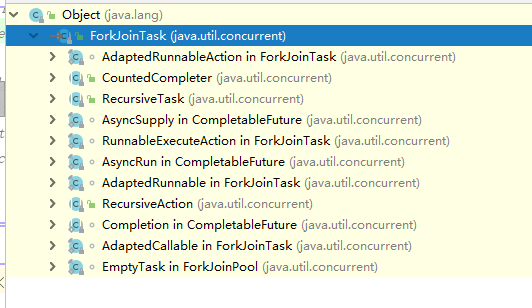
其中常用的有:
1)RecursiveAction ,用于没有返回结果的任务
2)RecursiveTask<V> , 用于有返回结果的任务
Task要通过ForkJoinPool来执行,使用submit 或 invoke 提交,两者的区别是:invoke是同步执行,调用之后需要等待任务完成,才能执行后面的代码;submit(有返回值) ,execute(无返回值) 是异步执行。

Task提交后完成后 可以通过task的join()和 get()方法获得返回结果
在我们自己实现的compute方法里,首先需要判断任务是否足够小,如果足够小就直接执行任务。如果不足够小,就必须分割成两个子任务,每个子任务在调用invokeAll方法时,又会进入compute方法,看看当前子任务是否需要继续分割成孙任务,如果不需要继续分割,则执行当前子任务并返回结果。使用join方法会等待子任务执行完并得到其结果。
get():等待任务执行完成,并返回计算结果
如果当前线程是ForkJoinWorkerThread,调用doJoin方法获取结果
如果当前线程不是ForkerJoinWorkerThread,调用externalInterruptibleAwaitDone方法。
任务执行完成返回后,如果任务完成状态是CANCELLED,抛出CancellationException异常。如果任务完成状态是EXCEPTIONAL,将任务执行过程中抛出的异常包装成ExecutionExcepiton重新抛出。
ForkJoinTask的几种任务状态
volatile int status; // accessed directly by pool and workers
static final int DONE_MASK = 0xf0000000; // mask out non-completion bits
static final int NORMAL = 0xf0000000; // must be negative //已完成
static final int CANCELLED = 0xc0000000; // must be < NORMAL //被取消
static final int EXCEPTIONAL = 0x80000000; // must be < CANCELLED //出现异常
static final int SIGNAL = 0x00010000; // must be >= 1 << 16 //信号
static final int SMASK = 0x0000ffff; // short bits for tags
/** * Waits if necessary for the computation to complete, and then * retrieves its result. * * @return the computed result * @throws CancellationException if the computation was cancelled * @throws ExecutionException if the computation threw an * exception * @throws InterruptedException if the current thread is not a * member of a ForkJoinPool and was interrupted while waiting */ public final V get() throws InterruptedException, ExecutionException { int s = (Thread.currentThread() instanceof ForkJoinWorkerThread) ? doJoin() : externalInterruptibleAwaitDone(); Throwable ex; if ((s &= DONE_MASK) == CANCELLED) throw new CancellationException(); if (s == EXCEPTIONAL && (ex = getThrowableException()) != null) throw new ExecutionException(ex); return getRawResult(); }
/**
* Implementation for join, get, quietlyJoin. Directly handles
* only cases of already-completed, external wait, and
* unfork+exec. Others are relayed to ForkJoinPool.awaitJoin.
*
* @return status upon completion
*/
private int doJoin() {
int s; Thread t; ForkJoinWorkerThread wt; ForkJoinPool.WorkQueue w;
return (s = status) < 0 ? s :
((t = Thread.currentThread()) instanceof ForkJoinWorkerThread) ?
(w = (wt = (ForkJoinWorkerThread)t).workQueue).
tryUnpush(this) && (s = doExec()) < 0 ? s :
wt.pool.awaitJoin(w, this, 0L) :
externalAwaitDone();
}
/**
* Implementation for invoke, quietlyInvoke.
*
* @return status upon completion
*/
private int doInvoke() {
int s; Thread t; ForkJoinWorkerThread wt;
return (s = doExec()) < 0 ? s :
((t = Thread.currentThread()) instanceof ForkJoinWorkerThread) ?
(wt = (ForkJoinWorkerThread)t).pool.
awaitJoin(wt.workQueue, this, 0L) :
externalAwaitDone();
}
join():阻塞当前线程并等待获取结果,得到结果正常则返回值,得到结果异常 则抛出异常!
/** * Returns the result of the computation when it {@link #isDone is * done}. This method differs from {@link #get()} in that * abnormal completion results in {@code RuntimeException} or * {@code Error}, not {@code ExecutionException}, and that * interrupts of the calling thread do <em>not</em> cause the * method to abruptly return by throwing {@code * InterruptedException}. * * @return the computed result */ public final V join() { int s; if ((s = doJoin() & DONE_MASK) != NORMAL) reportException(s); return getRawResult(); }
pool.invoke() 本身也是调用了task.join() 可以返回结果
task.invok() 与task.join()类似 只不过调用的是doInvoke() 而非doJoin()
public class UseForkJoin { public static final int MAX = 100; private static class SumTask extends RecursiveTask<Integer> { /** * 自定义的任务大小 */ private int perSize = MAX / 10; /** * 起始数 */ private int fromIndex; /** * 结尾数 */ private int toIndex; public SumTask(int fromIndex, int toIndex) { this.fromIndex = fromIndex; this.toIndex = toIndex; } @Override protected Integer compute() { if (toIndex - fromIndex < perSize) { int count = 0; for (int i = fromIndex; i <= toIndex; i++) { count = count + i; } return count; } else { int mid = (fromIndex + toIndex) / 2; SumTask left = new SumTask(fromIndex, mid); SumTask right = new SumTask(mid + 1, toIndex); invokeAll(left, right);//此处invokeAll会不断的调用执行compute方法 直到满足toIndex-fromIndex<perSize (递归) return left.join() + right.join(); } } } public static void main(String[] args) { //范式 ForkJoinPool pool = new ForkJoinPool(); SumTask task = new SumTask(0, 100); // Integer invoke = pool.invoke(task); pool.invoke(task); Integer join = task.join(); System.out.println(join); } }
2.CountDownLatch
CountDownLatch这个类能够使一个线程等待其他线程完成各自的工作后再执行。如主线程在其他初始化线程启动完成后再执行。 闭锁:闭锁是一种同步工具,可以延迟线程直到其达到其终止状态。
CountDowmLatch是通过一个计数器来实现的,计数器的初始值为初始任务量。每当完成一个任务后,计数器的值就会减1(countDown()方法).,当计数器的值达到0时,表示所有任务已完成 然后 闭锁上 等待 await() 方法的线程就可以恢复执行任务。

public class UserCountDownLatch { static CountDownLatch latch = new CountDownLatch(6); private static class CountThread extends Thread { @Override public void run() { System.out.println("CountThread running..."); SleepTools.second(1); System.out.println("CountThread end"); latch.countDown(); } } private static class BusThread extends Thread { @Override public void run() { try { latch.await(); } catch (InterruptedException e) { e.printStackTrace(); } for (int i = 0; i < 4; i++) { System.out.println("BusThread" + Thread.currentThread().getId() + " do business-----"); } } } private static class afterThread implements Runnable { @Override public void run() { System.out.println(Thread.currentThread().getName() + " init something..."); latch.countDown(); System.out.println("init complete!"); System.out.println("after init do something..."); SleepTools.second(2); System.out.println("after end..."); latch.countDown(); } } public static void main(String[] args) { new BusThread().start(); for (int i = 0; i < 3; i++) { new CountThread().start(); } new Thread(new afterThread()).start(); System.out.println("main is running..."); SleepTools.second(3); System.out.println("main end!"); latch.countDown(); } }
3.CyclicBarrier
栅栏类似于闭锁,它能阻塞一组线程直到某个事件的发生。栅栏与闭锁的关键区别在于,所有的线程必须同时到达栅栏位置,才能继续执行。闭锁用于等待事件,而栅栏用于等待其他线程。

public class UseCyclicBarrier { // static CyclicBarrier barrier = new CyclicBarrier(4); static CyclicBarrier barrier = new CyclicBarrier(4, new CollectThread()); private static ConcurrentHashMap<String, Long> resultMap = new ConcurrentHashMap<>(); /** * 汇总线程(barrierAction) 当屏障都执行(触发)完成后执行该线程任务 * the command to execute when the barrier is tripped */ private static class CollectThread implements Runnable { @Override public void run() { StringBuffer result = new StringBuffer(); for (Map.Entry<String, Long> workResult : resultMap.entrySet()) { result.append(workResult.getValue() + ","); } System.out.println(" the result = " + result); System.out.println("do other thing........"); } } /** * 相互等待的线程,所有的线程调用await()以后才一同执行之后的业务逻辑 * barrier可重复调用,在次调用 完成 会再次触发 CollectThread */ private static class SubThread implements Runnable { @Override public void run() { long id = Thread.currentThread().getId(); resultMap.put(Thread.currentThread().getId() + "", id); try { SleepTools.ms(1000); System.out.println("Thread " + id + "is running..."); barrier.await(); System.out.println("Thread " + id + "is end..."); //barrier可重复调用,在次调用 完成 会再次触发 CollectThread //barrier.await(); } catch (InterruptedException e) { e.printStackTrace(); } catch (BrokenBarrierException e) { e.printStackTrace(); } } } public static void main(String[] args) { /** * 主线程中并没有调用CollectThread */ for (int i = 0; i < 4; i++) { Thread thread = new Thread(new SubThread()); thread.start(); } } }
4.Semaphore 信号量
Semaphore类是一个计数信号量,必须由获取它的线程释放, 通常用于限制可以访问某些资源(物理或逻辑的)线程数目。
一个信号量有且仅有3种操作,且它们全部是原子的:初始化、增加和减少
增加可以为一个进程解除阻塞-> acquire()
减少可以让一个进程进入阻塞-> release()
public class UseSemaphore2 { static Semaphore semaphore = new Semaphore(10); /** * 存放资源的容器 */ private static LinkedList<Integer> list = new LinkedList<>(); /** * 释放资源 */ public void release() { synchronized (list) { list.addLast(new Random().nextInt(100)); } /** * 将许可证放回,释放资源 通知没有拿到资源的一方执行 */ semaphore.release(); System.out.println(Thread.currentThread().getId() + " 释放了资源。。。" + semaphore.availablePermits()); } /** * 获取资源 */ public void fetch() { /** * acquire()拿不到许可证 时会等待,拿到了继续执行 * 获取到许可证后 许可证总量减少 */ try { semaphore.acquire(); SleepTools.second(1); } catch (InterruptedException e) { e.printStackTrace(); } synchronized (list) { if (list.size() > 0) { list.removeFirst(); } } System.out.println(Thread.currentThread().getId() + " 获取资源。。。" + semaphore.availablePermits()); } private static class BusThread implements Runnable { private UseSemaphore2 semaphore; public BusThread(UseSemaphore2 semaphore) { this.semaphore = semaphore; } @Override public void run() { semaphore.fetch(); semaphore.release(); } } public static void main(String[] args) { UseSemaphore2 semaphore = new UseSemaphore2(); for (int i = 0; i < 50; i++) { new Thread(new BusThread(semaphore)).start(); } } }
5.Exchanger
可用于两个线程之间交换信息。可简单地将Exchanger对象理解为一个包含两个格子的容器,通过exchanger方法可以向两个格子中填充信息。当两个格子中的均被填充时,该对象会自动将两个格子的信息交换,然后返回给线程,从而实现两个线程的信息交换。
public class UseExchange { private static final Exchanger<Set<String>> exchange = new Exchanger<Set<String>>(); public static void main(String[] args) { new Thread(new Runnable() { @Override public void run() { Set<String> setA = new HashSet<String>();//存放数据的容器 try { setA.add("A1"); setA.add("A2"); setA.add("A3"); setA = exchange.exchange(setA);//交换set /*处理交换后的数据*/ Iterator<String> iterator = setA.iterator(); while (iterator.hasNext()) { System.out.println("after exchange setA:" + iterator.next()); } } catch (InterruptedException e) { } } }).start(); new Thread(new Runnable() { @Override public void run() { Set<String> setB = new HashSet<String>();//存放数据的容器 try { setB.add("B1"); setB.add("B2"); setB.add("B3"); setB.add("B4"); setB = exchange.exchange(setB);//交换set /*处理交换后的数据*/ Iterator<String> iterator = setB.iterator(); while (iterator.hasNext()) { System.out.println("after exchange setB:" + iterator.next()); } } catch (InterruptedException e) { } } }).start(); } }
5.Callable,Future,FutureTask
前面说过 启动一个线程有两种方式, 继承自Thread 或是 实现Runnable,然后交给Thread运行,但是这两种方式启动线程都没有返回结果。
Future :在 java.util.concurrent包中提供了Future 对于具体的Runnable或者Callable任务的执行结果进行取消,查询是否完成,获取结果。必要时通过get方法获取执行结果,该方法会阻塞直到任务返回结果。

Callable : 同样位于java.util.concurrent包下,是一个泛型接口,通过 call()方法能够返回泛型结果 或是抛出异常。和Runnable有相似之处,但Runnable并不能返回结果 或是抛出异常。
/** * A task that returns a result and may throw an exception. * Implementors define a single method with no arguments called * {@code call}. * * <p>The {@code Callable} interface is similar to {@link * java.lang.Runnable}, in that both are designed for classes whose * instances are potentially executed by another thread. A * {@code Runnable}, however, does not return a result and cannot * throw a checked exception. * * <p>The {@link Executors} class contains utility methods to * convert from other common forms to {@code Callable} classes. * * @see Executor * @since 1.5 * @author Doug Lea * @param <V> the result type of method {@code call} */ @FunctionalInterface public interface Callable<V> { /** * Computes a result, or throws an exception if unable to do so. * * @return computed result * @throws Exception if unable to compute a result */ V call() throws Exception; }
FutureTask:由于FutureTask仅仅是一个接口,无法直接用来创建对象因此有了FutureTask


/** * A {@link Future} that is {@link Runnable}. Successful execution of * the {@code run} method causes completion of the {@code Future} * and allows access to its results. * @see FutureTask * @see Executor * @since 1.6 * @author Doug Lea * @param <V> The result type returned by this Future's {@code get} method */ public interface RunnableFuture<V> extends Runnable, Future<V> { /** * Sets this Future to the result of its computation * unless it has been cancelled. */ void run(); }
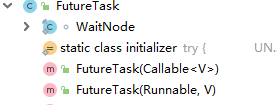
由于FutureTask实现了RunnableFuture ,RunnableFuture 同时继承了Runnbale和Future
所以我们需要通过FutureTask把一个Callable包装成Runnable,然后再通过这个FutureTask拿到Callable运行后的返回值。
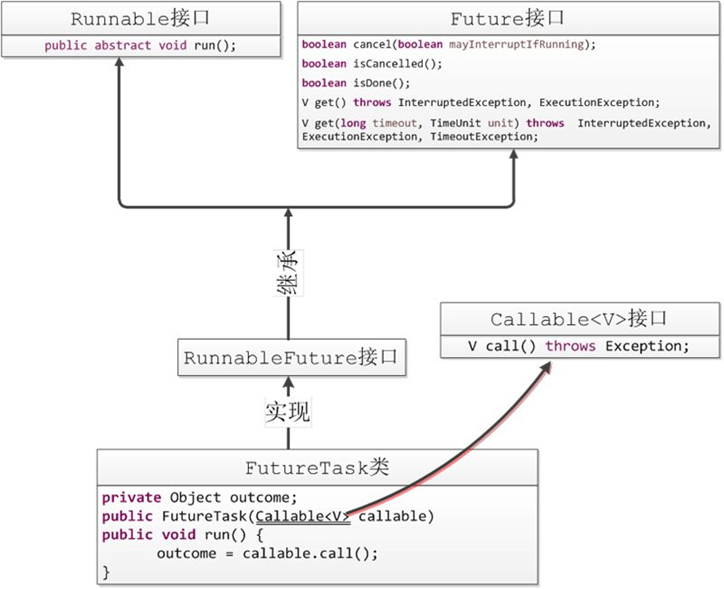
public class UserCallable {
private static class CallThread implements Callable<Integer> {
@Override
public Integer call() throws Exception {
int result = 0;
for (int i = 0; i <= 100; i++) {
result += i;
}
System.out.println("Call result:" + result);
return result;
}
}
public static void main(String[] args) throws ExecutionException, InterruptedException {
FutureTask<Integer> task = new FutureTask<Integer>(new CallThread());
new Thread(task).start();
Integer integer = task.get();
System.out.println("main result:" + integer);
}
}
参考:http://enjoy.ke.qq.com